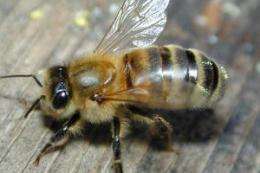Bees show off the perfect landing

(PhysOrg.com) -- Honey bees undergo a sudden transition from speeding aircraft to hovering helicopter as they perform the delicate art of landing on a flower.
Unlike the ‘controlled crash’ of a fly landing, the bee lands with utmost delicacy after ‘reading’ its airspeed visually, hovering above its landing ground and sensing it with vision, feelers and legs.
Scientists worldwide have devoted decades to studying how honeybees navigate their way around the landscape but now a team from The Vision Centre, The Queensland Brain Institute at The University of Queensland, and Lund University has revealed for the first time how they perform the final, but tricky art of landing.
“As any trainee pilot knows, landing is one of the hardest things to do, as everything around you is changing so quickly,” Professor Mandyam Srinivasan said.
“It requires excellent co-ordination to get the speed, angle, distance and touchdown point exactly right - especially if, as in the case of the bee, the landing surface is sloping or even upside down.”
The team used a special tiltable bee-landing platform and a high-speed camera to film the bees in the final moments of touchdown, and identify each of their separate actions.
On approach to their target the bees use ‘optic flow’, the stream of visual signals provided by their eyes as the landscape speeds past, to slow down and move from forward-flight to stable hover mode about 16mm from the platform, where they came to a dead stop.
They hovered for a few thousandths of a second until their hind legs contacted the landing ground, and the lowered themselves gently onto it - regardless of the angle at which it was tilted.
However, when the bees landed on surfaces ranging from vertical to upside down, their antennae came closest to the surface during the hover phase. The team saw the antennae graze the surface and this mechanical contact triggered the bees to reach up with the front legs, grasp hold of the surface and then slowly heave their middle and hind legs up too.
“We hadn’t expected the antennae to play a role and it adds a further dimension to the ‘instrumentation’ the bee is using in order to achieve the perfect landing,” said Professor Srinivasan, who has been studying honey bees for more than 20 years.
More subtly still the bee appears to use its visual system to correctly position its antennae, in order to ‘read’ the actual slope of the landing surface. However this creates a puzzle: because the bee is hovering and no longer experiencing optic flow from its forward motion, it must be using some other kind of visual sensing, such as stereo vision.
“We are keen to explore this possibility,” Professor Srinivasan said.
Another intriguing question is raised by the fact the bees are most comfortable on - indeed seem perfectly adapted for - slopes of about 60 degrees.
“We’ll have to see if that is the typical slope presented by the petals of the average flower,” he adds.
More information: The research “The moment before touchdown: landing manoeuvres of the honeybee Apis mellifera” by C. Evangelista, P. Kraft, M. Dacke, J. Reinhard and M. V. Srinivasan appears in the latest issue of the Journal of Experimental Biology.
Provided by University of Queensland


















